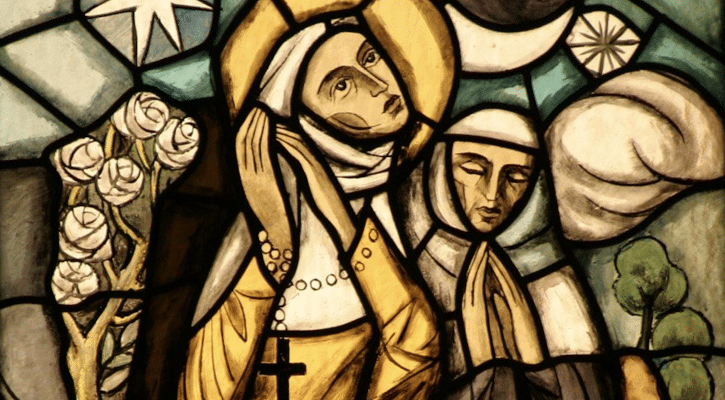Within each of us is the potential to be a light focusing attention on God’s presence in our world. Clare of Assisi’s life reveals just how much light she shed. As a friend and as cofounder of the Franciscan movement, she supported Francis as he discerned God’s message for himself and his followers. Together with her sisters, she wrote the first Rule written for religious women by a woman. She modeled the ability for the authority or power of a group to be held by the entire group (collegiality).
Clare’s life continues to speak to all of us. She challenges us to incorporate simplicity, singleness of purpose and unity within families and communities into the complexity of our 21st-century lives.
Clare was born in 1193 in Assisi, a small town in the scenic Umbrian Valley of Italy. She was born of nobility, the oldest child of Ortulana and Favarone di Offreduccio. At the end of the 12th and the beginning of the 13th century, Italy was a cauldron of political and military strife. Society was divided into two groups: the maiores and minores. The maiores were the nobility. The minores were former serfs, who had become merchants, craftsmen and field workers. These two groups were continually fighting for power among themselves.
In her early youth, Clare was exiled to Perugia. While the men in the family were off fighting their wars, the women chose to live as penitents. Ortulana, along with her daughters, as well as other women among Clare’s family and friends, were fasting, praying, bringing food to the poor and visiting prisoners.
This time of suffering and exile became a time of spiritual formation. Many of the women living with Clare in Perugia, including her mother and sisters, later became some of Clare’s first followers in San Damiano. In 1205, Clare’s family returned to Assisi. Francis had already begun his conversion. He had publicly renounced his father and started rebuilding San Damiano. In 1208, he began preaching. Clare’s cousin Rufino became one of his early followers.
Clare’s household had to have experienced the stir that Francis was causing. An eyewitness, cited in the Acts of the Process of Canonization [of Clare], said that, during this time, Clare went to hear Francis preach, gave him some money to rebuild churches and to feed the poor, and arranged to talk to him in private.
Clare and Francis were both experiencing God breaking into their lives, changing them and calling them to give themselves over to God. Both were facing unknowns and both were probably frightened and unsure of themselves. It must have been a comforting grace to meet a kindred spirit and to encounter another human being who was experiencing the same call and facing the same doubts.
Clare’s sister Beatrice tells us (in the document of the canonization process) that Francis first initiated the visit with Clare. Some speculation suggests that women were asking to join his movement and Francis needed a strong woman to lead the others.
Clare’s reputation for holiness was well known in Assisi. She would be the perfect leader. Who went to whom first is unimportant. The important reality was that God had a plan and that Francis and Clare were open to being led. Francis and the brothers received Clare on Palm Sunday night at the chapel of St. Mary of the Angels (the Portiuncula) in the year 1212. Shortly after this, she was taken to San Paolo, a Benedictine monastery in Bastia.
The men in Clare’s family were not happy with her following Francis. Their power and wealth were diminishing with the changes in society. Clare was beautiful and they had hoped that her marriage would bring prestige and continued wealth into the family. They followed her to San Paolo with every intention of bringing her home.
Clare instead held on to the altar and claimed sanctuary. She had made her choice. She would never turn back.
Clare’s sister Catherine, soon to be called Agnes, joined Clare. The two lived for a while with a group of Beguines (13th-century women under vows) in Sant’Angelo in Panzo until Francis brought them to the church of San Damiano. There, the Lord gave them sisters and their community grew quickly.
Shaping a Future with Confidence
Clare’s community was to be vastly different from the monastic communities of her time. The sisters were to live poorly without large land holdings. Like Francis, their Rule would be to embrace the gospel form of life. They would all be of equal rank, and all decisions affecting their life would be made by all of them.
They would have an abbess, but she would consider herself “the servant of the sisters” and she would lead more by her example of virtue than by instruction or admonition.
Clare was the perfect follower of Francis. She understood his message and would spend her entire life making it a lived reality. Her life and the lives of the early sisters, however, were not easy ones.
Francis died young. Clare outlived him by 27 years. She remained firm and kept the ideal alive, despite Francis’ absence and the dissension among his brothers. The Church would see the poverty of her life as too difficult. She negotiated with popes and worked to get her Rule approved until the day before she died—August 10, 1253.
Most of her life, Clare lived with sickness. While she complained little of her own illness, she is known for frequently healing others. She lived an enclosed life within the narrow confines of a small monastery in Assisi. Yet her story is known around the entire world today.
Clare’s Character Challenges Us
Clare was a woman of prayer, and her entire life was lived in trust of the God whom she knew loved her. She needed little material wealth because she trusted that God would care for all her physical needs. God never let her down. It takes deep faith to live so, but anyone who has tried to live dependent on God learns quickly the joy of simplicity.
Clutter blocks freedom and blurs perception. Living simply helps one develop an attitude or willingness to be emptied. One quickly learns what is important. Those who live simply learn to live with open hands: to appreciate what is given but to be equally willing to let go, when letting go is what is needed.
Contemplative living was Clare’s reason for living simply. One needs to be poor to have the space to meet God. Clare, by her way of life, witnessed to others the one thing necessary and found herself united with all people in sharing her need for and reliance on God.
The most genuine poverty seems to come from within. Individuals in poverty make families and communities poor. Life’s biggest challenge seems to be embracing inner poverty. It takes real honesty to face oneself, to acknowledge clinging to possessions and to admit attraction to power and privilege, tendencies we all share.
Courage is needed to be poor, to recognize the need for conversion and not to be overwhelmed by it. Embracing inner poverty can turn lives upside down. In facing the struggle, though, we—like Clare—can recognize that areas of weakness are also areas of grace.
Our own struggle with sinfulness teaches patience and forgiveness as we encounter the mistakes and failures of others. Conversion is the only route to transformation. Poverty frees and enables Christians to face the cross. In experiencing the cross, we—like Clare—are transformed.
Clare, in a letter to Ermentrude of Bruges (a Flemish founder trying to live in the spirit of Clare and her followers), tells us: “Love God and Jesus, who was crucified for us, from the depth of your heart, and never let the thought of Him leave your mind. Meditate constantly on the mysteries of the cross. Do not be afraid, my daughters. God, who is faithful in all His works and holy in all His deeds, will pour out His blessings upon you. God will be your helper and best consoler. God is our redeemer and our eternal reward.”
Suffering is a part of life. No one can escape suffering, but how it’s understood informs and influences how one handles it. Clare focused her daughters on Christ crucified. She prayed before the crucified Jesus and contemplated the Gospel accounts of the Passion.
At first glance, this can seem like an unhealthy stress on pain or a glorification of suffering. That was not Clare’s intention. Clare knew that staying with Jesus in the Passion accounts would move her beyond suffering to a deep realization of Jesus’ love. Recognizing such love creates a burning desire to be one with the crucified. In short, there is no embracing the cross that does not lead to at least hints of resurrection!
St. Clare was no victim-martyr. She did not go out searching for suffering. She was, however, open to facing the suffering that came her way. She knew grace would be present and that this grace would give her the strength and courage she needed. It would also give her the vision to see beyond herself and grasp the insights that only God could teach.
Clare learned that embracing the cross opens one totally to God, who keeps teaching the depths of love. This union with God unites neighbors. Our suffering becomes one with that of others. Together, we learn the compassion and love mirrored by Jesus.
Clare wrote four letters to Agnes of Prague, the queen of Bohemia, who became a Poor Clare. (Clare’s sister Agnes is known as Agnes of Assisi.) In her third letter to Agnes, she writes, “The soul of a faithful person is greater than heaven itself, since the heavens and the rest of creation can not contain the creator and only the faithful soul is God’s dwelling place and throne. As the glorious Virgin of Virgins carried Jesus materially, so we too, by following in her footprints, especially those of poverty and humility, can without a doubt, always carry Him spiritually in our chaste and virginal bodies, holding the one by whom all things are held together, possessing that which in comparison with the other transitory possessions of the world, we will possess more securely.”
Taking these words to Agnes seriously would change the way people look at themselves and others. The answer lies within. The realization of this “indwelling of God” calls for a respect and an appreciation for who we are. Clare taught her sisters to see themselves as temples of God, mirrors of Christ and revelations of the Holy Spirit. Such servanthood holds none of the unhealthy implications of being either slaves or doormats.
It calls us to mirror the self-emptying compassion we have seen mirrored in Jesus. It is the same Jesus, as we clearly know, who dwells in our neighbor. Our neighbors are also temples of God, mirrors of Christ and revelations of the Spirit. Our God dwells in each of us and each of us uniquely manifests our God.
Like Mary, we are called to birth our God for one another, to bring to life the reality of God’s presence.
Service goes beyond merely doing for one another. Service, in Clare’s view, is a calling to be reflections of God for one another. Within each of us, Clare saw clearly, is a seed that awaits birth. We are encouraged to endure life’s labor pangs and bring forth life. Not to do so would be to have the manifestation of God be stillborn.
This is the vision that Clare held with Francis, one that they both gleaned from the gospel. It is a vision of light embraced by Poor Clares, but one that can illuminate the Church at large in this new century.
Being a Poor Clare Today
Clare’s life and charism live on in the lives of the many Poor Clares living faithfully her spirit in their monasteries today. I would like to share what I see as our message to the world.
Potential Unlimited. I believe that, although we live in a small and rather confined space, we touch the world and the whole world touches us. Not many people get to travel to many places or affect large populations. Most of society is enclosed by family structures, jobs and daily routines. Every life has its limits in time and space.
Our life as Clares speaks of the countless areas of potentiality and creativity that emerge within such limits. The contemplative stance opens eyes, ears and heart and invites the individual to hear the “more.”
Ministry of Prayer. The same maple tree can show a new dimension of life to us daily. The same people are ever changing, ever growing and always calling forth new responses from us. Prayer enables us to minister to millions, most of whom we never meet, but for whom we genuinely care. Limited space can either make a world very small and closed in on itself or challenge us to ever keener perceptions and deeper insights.
This is a message of hope and importance to those who are “shut-ins,” persons enclosed in their bodies through paralysis, to the exile and the prisoner, and to the ordinary person simply trying to find meaning in small daily chores. Commitment to the Common Life. We live in a world where commitment is difficult and it seems easier to end a relationship than to try to work it through. Our commitment to sisterhood speaks of our belief in humanity and in the gift we are to one another. We teach that focus on the good unifies.
We know the potential for goodness and grace lies within each person, but that it takes work, encouragement and support to help it grow and surface. Living in relationship is hard, but the Clare life models and encourages the forgiveness, the honesty and the patience that can make it happen.
Less Is More. Consumerism attacks on every side. The commercials on television, the advertisements in magazines and the billboards on our highways all tell us of things we absolutely must have in order to be happy.
Following Clare, we profess that less is more. Who we are is more important than what we have. Living simply opens one to an appreciation of what one already has. Our life teaches appreciation for the little things: a single flower, a homemade birthday card, fresh bread and the smile of another. Our prayer is the prayer of the ordinary. We claim a mysticism of everyday. It is not a form of prayer reserved for the special, the gifted or the holier. Everyone is called to walk in the presence of God. Our ordinary mysticism is within the reach of all people.
Healing Happens. We live in a hurting world. Suffering overwhelms people. We are not removed from that reality. We see it on the daily news. We hear it in the pleas for prayer contained in the emails, letters and phone calls that we receive. We touch it in our neighbors, our families and our own lives. We cannot remove or take away all the pain that we witness. Life is messy; even Jesus did not clean up all the messiness in the lives of the people he encountered.
St. Clare has taught us to bring our messiness to God. God teaches us what we need to know. We are always looking for solutions. Our contemplative life teaches us that answers are not always clearly visible or even available. Yet, our contemplative stance also teaches a way of living peacefully with the questions.
Our way of life is not a way of ignorance or avoidance of reality. It is a way of faith. It is a way of knowing that God is bigger than we are! It is a way of believing that God always comes through.









7 thoughts on “Loving St. Clare of Assisi”
Great read! Thank you
Thank You for all the answered prayers and for continually praying for all Filipinos! Love what You have been doing…
Thank you for sharing this full story of St Clare. In a world of materialism it is refreshing to hear St Clare’s life and works and to realize we are not of this world but simply in it. We are of God!
Thank you!
I enjoying reading the life of our Saints.
We have a lot to learn from them.
Great to be reminded of St Clare today, on her feast Day – Thank you, Mary Grey.
The reflection on loving St Clare by Sister Claire Andre is one of the most beautiful reflections I have read on St. Clare! It has inspired me! As a Discalced Carmelite friar, it has inspired me to read more about St. Clare. I have a Franciscan heart as well because St Francis was an important Saint in my
own journey. Fr. Daniel Chowning, ocd
Wow! Thank you ever so much for your teacing on St Clare. Have grown to love her only in the last few years, & wish I could dwell on more. Have mega heath & finance problems, inc. lack of mobility. Would be so grateful if St Clare would help me with a miracle. Please pray for me
Marian
Comments are closed.